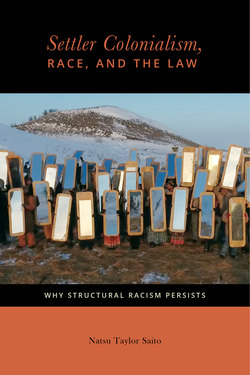Читать книгу Settler Colonialism, Race, and the Law - Natsu Taylor Saito - Страница 41
На сайте Литреса книга снята с продажи.
Internments
ОглавлениеMass incarceration was the inevitable consequence of the “removals.” Recognizing that the Indigenous peoples who survived relocation had to live somewhere, the government assigned them to “agencies,” that is, reservations. The notion of “reserved lands,” like “relocation,” sounds relatively benign; it might not be home, but it is land upon which to start a new life. This is, however, an entirely inaccurate perception. Even under the most humane conditions, forced relocation is devastating, and it has an intensified effect on peoples for whom land is not a fungible commodity. As former UN special rapporteur James Anaya notes, Indigenous peoples “are indigenous because their ancestral roots are embedded in the lands on which they live, or would like to live.”85 Cultures, cosmologies, languages, identities, and responsibilities that have evolved in relation to particular territories cannot simply be transplanted.86 Compounding this problem, virtually all of these peoples were being forced onto the territories of other Indigenous nations, “turn[ing] eastern tribes into proxy invaders of Indian territory across the Mississippi.”87
And, of course, the conditions under which Indigenous peoples were “removed” and “relocated” were anything but humane. Invariably, American Indians were confined to the poorest and least hospitable lands available, a significant problem even when their assigned reservations were located within their traditional territories. Thus, a Chiricahua Apache described the San Carlos reservation as “the worst place in all the great territory stolen from the Apaches. If anybody had ever lived there permanently, no Apache knew of it.”88 The government’s failure to provide adequate food or shelter dramatically intensified the trauma of forced relocation and triggered the rapid decline of already decimated populations.89 Trapped on barren lands without adequate food or shelter, survival seemed unlikely, prompting many interned peoples to attempt escape. But they were prisoners, allowed to leave their assigned agencies only with the permission of the military or a federal Indian agent,90 and fleeing provided the state with an excuse to revert to wholesale slaughter.
The Northern Cheyennes, for example, had been forced from their traditional Montana territory in 1877 and imprisoned in Oklahoma. By the fall of 1878, with their people dying of malaria, dysentery, and other illnesses, some three hundred Cheyennes made a desperate attempt to go home.91 Hoping to deter other escapes, General Philip Sheridan sent about fifteen thousand US troops in pursuit, with orders to “spare no measure . . . to kill or capture” the small group of escapees.92 The Cheyennes were incarcerated at Camp Robinson, Nebraska, where the government denied them food and firewood in the dead of winter to coerce them into returning to Oklahoma. In January 1879 the Cheyennes again escaped but were quickly tracked down, and about half their number, children included, were simply butchered.93 There could be no mistaking the message conveyed by such practices: American Indians had no alternative but to remain in their assigned locations, under whatever conditions the settler state chose to impose.
Within the settler imaginary that invented and asserted an exclusive entitlement to the land, Indians were, by definition, a military threat. This construction was not merely theoretical or rhetorical but enshrined in law and enforced by the police powers of the state well into the twentieth century.94 The experiences of the Chiricahua Apache illustrate this aptly. Finding their confinement at San Carlos intolerable, Geronimo’s band escaped and eluded government forces for a year and a half. In retaliation, following his 1886 surrender, the government shipped the entire Chiricahua population—children, elders, women, and even men who had fought for the United States—to military prisons in Florida and then Alabama. During their first eight years of incarceration, some 40 percent of the imprisoned Chiricahuas died, and it was not until the winter of 1913–14 that the survivors were transferred to a reservation in Oklahoma.95
Citing the expropriation of their lands and their lengthy imprisonment, in 1947 the Chiricahuas filed a claim with the Indian Claims Commission (ICC), a body established by the federal government in 1946 in an attempt to distinguish its territorial acquisitions from those of the Germans it was then prosecuting at Nuremberg.96 In 1971 the ICC finally awarded the Chiricahuas token payment for their lands, but refused to consider the imprisonment claim.97 On appeal, the Court of Claims acknowledged “that ‘the Apache Tribe did not prosper’ from twenty-seven years of imprisonment,” but refused to hold the government liable.98 In 1974 the Supreme Court denied certiorari, thereby confirming the settler state’s prerogative to indefinitely intern entire peoples in order to consolidate control over its claimed land base.99
